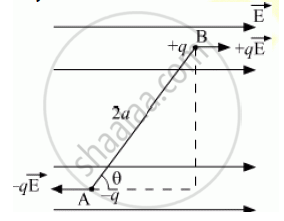Advertisements
Advertisements
Question
An electric dipole is held in a uniform electric field.
(i) Show that the net force acting on it is zero.
(ii) The dipole is aligned parallel to the field. Find the work done in rotating it through the angle of 180°.
Solution
(i) Consider an electric dipole consisting of two equal and opposite point charges, −q at A and + q at B, separated by a small distance 2a.

AB = 2a, having dipole moment
`|vecP| = q(2a)`
Let this dipole be held in a uniform external electric field `vecE`at an angle θ with the direction of `vecE`
Force on charge −q at A= − q ,`vecE` in a direction opposite to `vecE`
Force on charge +q at B = +q ,`vecE` along the direction of `vecE`
Net force on the dipole = qE − qE = 0
(ii) Work done on dipole, W = ΔU = pE (cos θ1 − cos θ2)
W = pE (cos0° − cos180°)
W = 2pE
RELATED QUESTIONS
Two charges 5 × 10−8 C and −3 × 10−8 C are located 16 cm apart. At what point(s) on the line joining the two charges is the electric potential zero? Take the potential at infinity to be zero.
Consider the situation shown in figure (31-E29). The width of each plate is b. The capacitor plates are rigidly clamped in the laboratory and connected to a battery of emf ε. All surfaces are frictionless. Calculate the value of M for which the dielectric slab will stay in equilibrium.

Derive an expression for the electric potential at any point along the axial line of an electric dipole.
Which of the following is correct for energy of a dipole in a uniform electric field?
The electric potential at a point on the equatorial line of an electric dipole is ______.
A hollow metal sphere of radius 5 cm is charged such that the potential on its surface is 10 V. The potential at a distance of 2 cm from the centre of the sphere is ______.
An electric field of 1000 V/m is applied to an electric dipole at angle of 45°. The value of electric dipole moment is 10-29 C.m. What is the potential energy of the electric dipole?
A point P lies at a distance x from the midpoint of an electric dipole on its axis. The electric potential at point P is proportional to ______.
